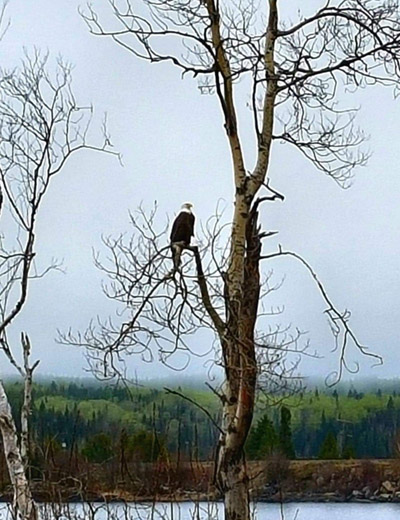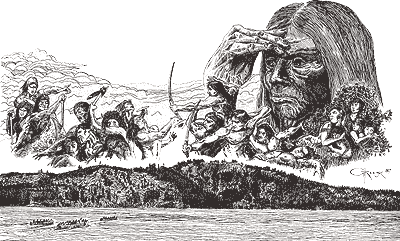Sioux Lookout lies on an old water route between Lake Superior and Lake Winnipeg. The route runs via the English River, Minnitaki Lake, Abram Lake, Frog Rapids, Pelican Lake, and Lac Seul.


Legend claims that late in the 1700’s, a decisive battle was fought at Pelican Lake and there is ample proof of its authenticity. For many years the Sioux of the Western Plains had trekked to Lake Superior to make trade with furs for the copper and silver used by the Ojibway living at the foot of the Sleeping Giant and beyond the Peeping Squaw. Once the trade had been made the Sioux would wait till night fall, then set their plan in motion. They covered themselves with the skins of large snakes and crawled into the wigwams of the Ojibway, and those who where not killed in their sleep, fled in terror.
Repeatedly, a number of Ojibway would escape by canoe only to be pursued by the Sioux and slaughtered.
One small band of Ojibway on seeing the approach of the Sioux at Lake Superior, did not wait for their offer of trade. They gathered their children and as many possessions as they could carry and paddled along the Maninistikwia River along the old waterways leading to the Northwest. This was the same route that the Sioux used on their return trip to what is now the Dakotas. The round trip took two years. It was necessary to camp for the winter at the mouth of the Winnipeg River where it empties into Lake Winnipeg.
The only hope that the Ojibway had was to out run the Sioux and make to the land of the Assiniboines on the prairies. The Ojibway lacked the speedy canoes, the fighting braves and the well trained women of the Sioux bands. None but the most experienced and fearless where chosen by the Sioux for this roundabout trip. Only the Sioux Chief was allowed to take his son, not yet a brave, on the trip, to learn the value of speed, intrigue, and swift killing to enrich the tribe.
The first band of Ojibway to escape the encounter with the Sioux at Lake Superior, had no more than a week’s head start on their enemy. Their progress was hampered by the elderly and small children on the long and hard portages. Frequent rests had to be made to hunt and fish for food.
The Ojibway finally reached the high peak of land on Pelican Lake and camped there. A lookout was posted day and night to watch the waters stretching eastward for signs of the Sioux’s approach. On a fair day, a man with keen eyesight could see 40 miles beyond Frog Rapids, across Abram Lake and to the south shores of Minnitaki Lake.
This particular summer morning, when the camp below was stirring awake, the lookout, with his hand shading his eyes to the rising sun, stiffened. Did he imagine it or did he catch the glimpse of the flash of sun reflecting off wet paddles?
He stood for a moment straining his eyes. Yes, one long war canoe, and then another and another far in the distance.
Swift as one of his arrows, the scout ran down the mountain side to warn the camp. Cooking fires where immediately stamped out. All but one small burning spot over which a pot was hung, remained. A council was called. The Ojibway could run or they could stand.
All the women and children were paddled out a small island in the middle of Pelican Lake and told to be absolutely quiet. The Council held a quick meeting and decided that the only strategy for survival was an ambush. The cliffs behind the camp would provide an excellent place for the Ojibway archers to hide and to rain their arrows down on the Sioux. Large fires where rekindled to create the atmosphere of great activity around the teepees. Then the young warriors armed with bows and arrows retreated in a semi-circle up the side of the mountain lookout. Only the old men remained. They busied themselves with fishing snares down at the water’s edge, willing sacrifices if need be for the preservation of their families and tribe.
Swiftly the powerful Sioux canoes approached, skillfully rode Frog Rapids (no steel bridge rainbowed the narrow waters then) and swept down with the current. So confident where the Sioux of victory, that they bought their women along with them to claim the loot and look after their personal needs.
The invaders leaped ashore screaming their war cries. The Sioux women remained in their canoes, being completely capable of warding off any surprise attack by water if necessary.
Contemptuously, the Sioux warriors dashed past the old men on the beach, and rushed the campsite. Immediately the elderly men went into action. They overturned the Sioux canoes and drowned the fighting women. At precisely the same time the Ojibway warrior descended from the hills around and encircled their old enemy.
In the great slaughter that followed, all the invading party were either killed or drowned. All save one little boy, snatched from under a bloody hatchet by a compassionate Ojibway woman. Later, that boy was adopted into the Ojibway tribe. In time he became one of their most respected Chieftains. He was called Ogemah (leader of the tribe). His ancestors still live in the area and bear his name.
Never again did the Sioux embark on their tours of destruction from the prairie to Lake Superior and after pillage and murder continue westward to Lake Winnipeg.
Further substantiation of this historical incident was the discovery years ago when the Canadian National Railway built a bridge over the Pelican Narrows, just downstream from Sioux Lookout. Here, caught in the rocks were many skeletons and skulls identified as Sioux remains.
Sioux Lookout was built across the lake from the scene of the battle on a sandy beach, many years later.
